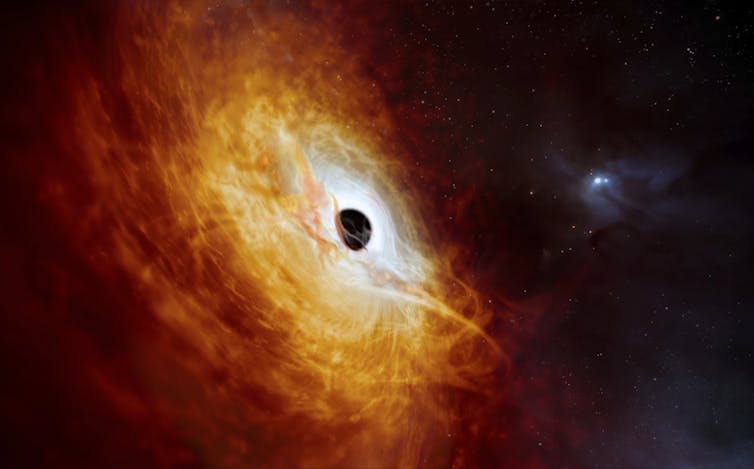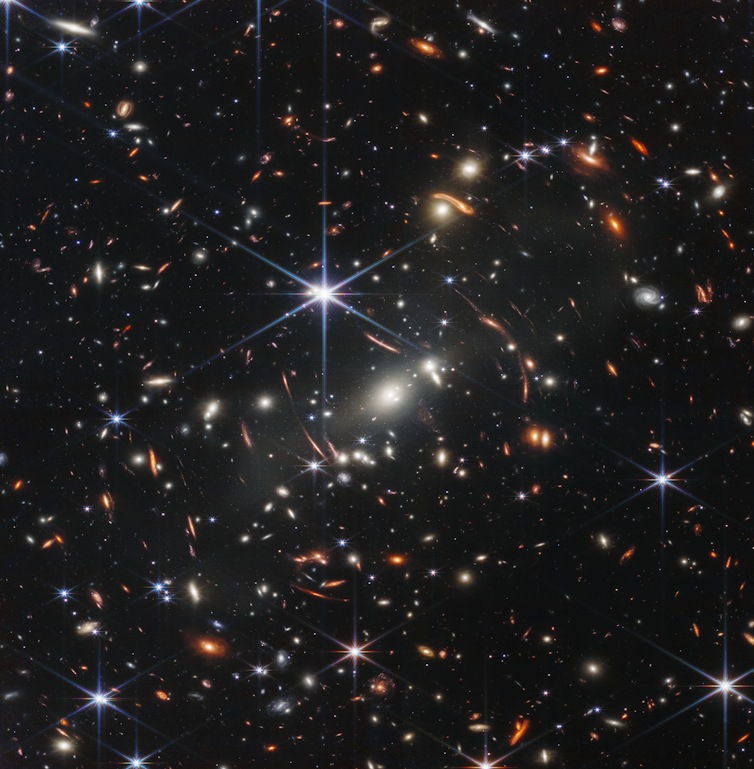Supermassive black holes grow by pulling in matter around them.
Fabio Pacucci, Smithsonian Institution
Astronomers exploring the faraway universe with the James Webb Space Telescope, NASA’s most powerful telescope, have found a class of galaxies that challenges even the most skillful creatures in mimicry – like the mimic octopus. This creature can impersonate other marine animals to avoid predators. Need to be a flatfish? No problem. A sea snake? Easy.
When astronomers analyzed the first Webb images of the remote parts of the universe, they spotted a never-before-seen group of galaxies. These galaxies – some hundreds of them and called the Little Red Dots – are very red and compact, and visible only during about 1 billion years of cosmic history. Like the mimic octopus, the Little Red Dots puzzle astronomers, because they look like different astrophysical objects. They’re either massively heavy galaxies or modestly sized ones, each containing a supermassive black hole at its core.
However, one thing is certain. The typical Little Red Dot is small, with a radius of only 2% of that of the Milky Way galaxy. Some are even smaller.
As an astrophysicist who studies faraway galaxies and black holes, I am interested in understanding the nature of these little galaxies. What powers their light and what are they, really?
The universe is full of countless galaxies, and the Webb telescope has helped astronomers study some of them.
The mimicking contest
Astronomers analyze the light our telescopes receive from faraway galaxies to assess their physical properties, such as the number of stars they contain. We can use the properties of their light to study the Little Red Dots and figure out whether they’re made up of lots of stars or whether they have a black hole inside them.
Light that reaches our telescopes ranges in wavelength from long radio waves to energetic gamma rays. Astronomers break the light down into the different frequencies and visualize them with a chart, called a spectrum.
Sometimes, the spectrum contains emission lines, which are ranges of frequencies where more intense light emission occurs. In this case, we can use the spectrum’s shape to predict whether the galaxy is harboring a supermassive black hole and estimate its mass.
Similarly, studying X-ray emisson from the galaxy can reveal a supermassive black hole’s presence.
As the ultimate masters of disguise, the Little Red Dots appear as different astrophysical objects, depending on whether astronomers choose to study them using X-rays, emission lines or something else.
The information astronomers have collected so far from the Little Red Dots’ spectra and emission lines has led to two diverging models explaining their nature. These objects are either extremely dense galaxies containing billions of stars or they host a supermassive black hole.
The two hypotheses
In the stars-only hypothesis, the Little Red Dots contain massive amounts of stars – up to 100 billion stars. That’s approximately the same number of stars as in the Milky Way – a much larger galaxy.
Imagine standing alone in a huge, empty room. This vast, quiet space represents the region of the universe in the vicinity of our solar system where stars are sparsely scattered. Now, picture that same room, but packed with the entire population of China.
This packed room is what the core of the densest Little Red Dots would feel like. These astrophysical objects may be the densest stellar environments in the entire universe. Astronomers aren’t even sure whether such stellar systems can physically exist.
Then, there is the black hole hypothesis. The majority of Little Red Dots display clear signs of the presence of a supermassive black hole in their center. Astronomers can tell whether there’s a black hole in the galaxy by looking at large emission lines in their spectra, created by gas around the black hole swirling at high speed.
Astronomers actually estimate these black holes are too massive, compared with the size of their compact host galaxies.
Black holes typically have a mass of about 0.1% of the stellar mass of their host galaxies. But some of these Little Red Dots harbor a black hole almost as massive as their entire galaxy. Astronomers call these overmassive black holes, because their existence defies the conventional ratio typically observed in galaxies.
There’s another catch, though. Unlike ordinary black holes, those presumably present in the Little Red Dots don’t show any sign of X-ray emission. Even in the deepest, high-energy images available, where astronomers should be able to easily observe these black holes, there’s no trace of them.
Few solutions and plenty of hopes
So are these astrophysical curiosities massive galaxies with far too many stars? Or do they host supermassive black holes at their center that are too massive and don’t emit enough X-rays? What a puzzle.
With more observations and theoretical modeling, astronomers are starting to come up with some possible solutions. Maybe the Little Red Dots are composed only of stars, but these stars are so dense and compact that they mimic the emission lines typically seen from a black hole.
Or maybe supermassive – even overmassive – black holes lurk at the cores of these Little Red Dots. If that’s the case, two models can explain the lack of X-ray emissions.
First, vast amounts of gas could float around the black hole, which would block part of the high-energy radiation emitted from the black hole’s center. Second, the black hole could be pulling in gas much faster than usual. This process would produce a different spectrum with fewer X-rays than astronomers usually see.
The fact that the black holes are too big, or overmassive, might not be a problem for our understanding of the universe, but rather the best indication of how the first black holes in the universe were born. In fact, if the first black holes that ever formed were very massive – about 100,000 times the mass of the Sun – theoretical models suggest that their ratio of black hole mass to the mass of the host galaxy could stay high for a long time after formation.
So how can astronomers discover the true nature of these little specks of light that are shining at the beginning of time? As in the case of our master of disguise – the octopus – the secret resides in observing their behavior.
Using the Webb telescope and more powerful X-ray telescopes to take additional observations will eventually uncover a feature that astronomers can attribute to only one of the two scenarios.
For example, if astronomers clearly detected X-ray or radio emission, or infrared light emitted from around where the black hole might be, they’d know the black hole hypothesis is the right one.
Just like how our marine friend can pretend to be a starfish, eventually it will move its tentacles and reveal its true nature.
Fabio Pacucci, Astrophysicist, Smithsonian Institution
This article is republished from The Conversation under a Creative Commons license. Read the original article.
































































